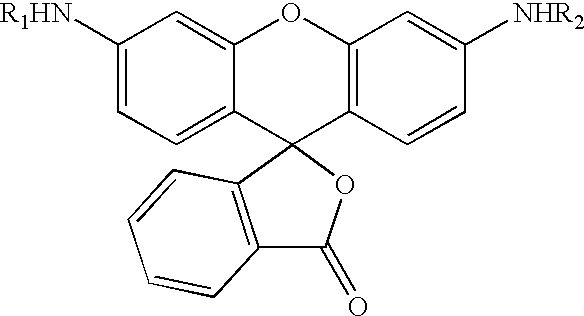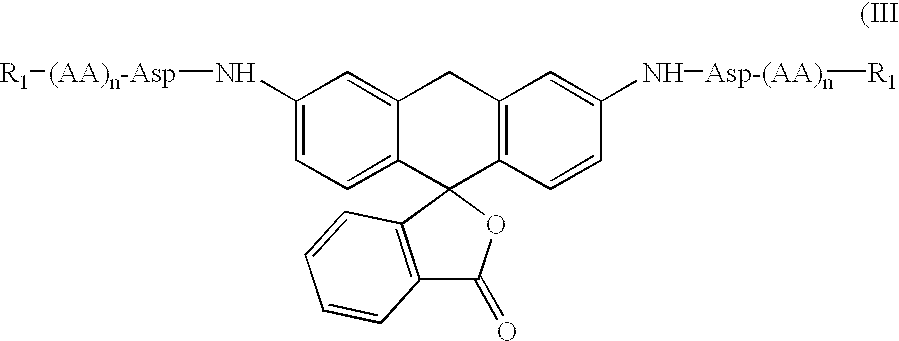Novel fluorogenic or fluorescent reporter molecules and their applications for whole-cell fluorescence screening assays for caspases and other enzymes and the use thereof
a reporter molecule and reporter technology, applied in the field of fluorogenic or fluorescent reporter molecules and their applications for whole-cell fluorescence screening assays for caspases and other enzymes, can solve the problems of cell death, excessive cellular suicide and organ failure, and the inability of htca assays to screen for compounds in inner cellular cells
- Summary
- Abstract
- Description
- Claims
- Application Information
AI Technical Summary
Problems solved by technology
Method used
Image
Examples
example 2
[Asp(OBu-t)].sub.2-Rhodamine 110 2HCl
[0838] A chilled solution of DMF / morpholine (3 mL, 1:1) was added dropwise into a stirred solution of [Fmoc-Asp(OBu-t)].sub.2-Rhodamine 110 (150 mg, 0.13 mmol) in dimethylformamide (3 mL). The solution was stirred for 20 min and it was poured into ice water (100 mL) and extracted with ethyl acetate (2.times.100 mL). The organic phase was washed with water (3.times.100 mL) and dried over Na.sub.2SO.sub.4. To the solution was added 1N HCl in ether (0.39 mL) and it was concentrated to give a red solid. The red solid was collected and dissolved in methanol (1 mL), and precipitated with ether (50 mL) to give the title compound (65 mg, 77%) as red solid. m.p. 200.degree. C. (dec).
example 3
[Z-Ala-Asp(OBu-t)].sub.2-Rhodamine 110
[0839] From benzyloxycarbonyl-L-alanine (376 mg, 1.69 mmol), EDC (258 mg, 1.35 mmol) and [Asp(OBu-t)].sub.2-Rhodamine 110 2HCl (50 mg, 0.072 mmo 1) in 1:1 Xanyhydrous DMF / pyridine (10 mL) at 0.degree. C. was obtained 63 mg (86%) of the title compound as a solid, mp 124-126.degree. C. .sup.1H NMR (CDCl.sub.3): .delta. 8.85 (d, 2H), 7.90 (m, 2H), 7.60 (m, 4H), 7.32 (m, 10H), 7.10 (m, 2H), 6.68 (m, 2H), 5.20 (s, 2H), 5.10 (d, 4H), 4.90 (s, 2H), 4.18 (m, 2H), 2.82 (m, 4H), 1.42 (m, 24H).
example 4
(Z-Ala-Asp).sub.2-Rhodamine 110
[0840] To the cooled solution (0.degree. C.) of [Z-Ala-Asp(OBu-t)].sub.2-R-hodamine 110 (41 mg, 0.038 mmol) in methylene chloride (5 ml) was added 50% trifluoroacetic acid in methylene chloride (16 mL). The solution turned orange and was stirred at room temperature for 3 h. The solvent was removed and the crude product was purified by flash column chromatography (EtOAc / CF.sub.3CO.sub.2H=20:0.5) to yield 34 mg (91%) of the title compound. .sup.1H NMR (CD.sub.3OD): .delta. 8.02 (d, J=8.1 Hz, 1H), 7.85 (s, 2H), 7.73 (t, J=7.5 Hz, 2H), 7.34-6.60 (m, 15 H), 5.08 (d, 4H), 4.05 (m, 2H), 2.95 (m, 4H), 1.38 (d, J=6.4 Hz, 6H).
PUM
 Login to View More
Login to View More Abstract
Description
Claims
Application Information
 Login to View More
Login to View More - R&D
- Intellectual Property
- Life Sciences
- Materials
- Tech Scout
- Unparalleled Data Quality
- Higher Quality Content
- 60% Fewer Hallucinations
Browse by: Latest US Patents, China's latest patents, Technical Efficacy Thesaurus, Application Domain, Technology Topic, Popular Technical Reports.
© 2025 PatSnap. All rights reserved.Legal|Privacy policy|Modern Slavery Act Transparency Statement|Sitemap|About US| Contact US: help@patsnap.com



